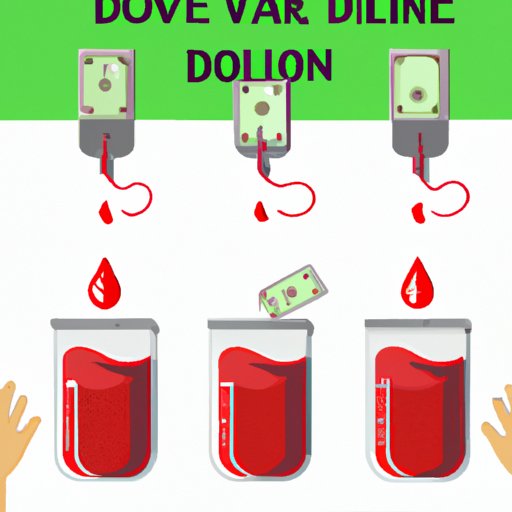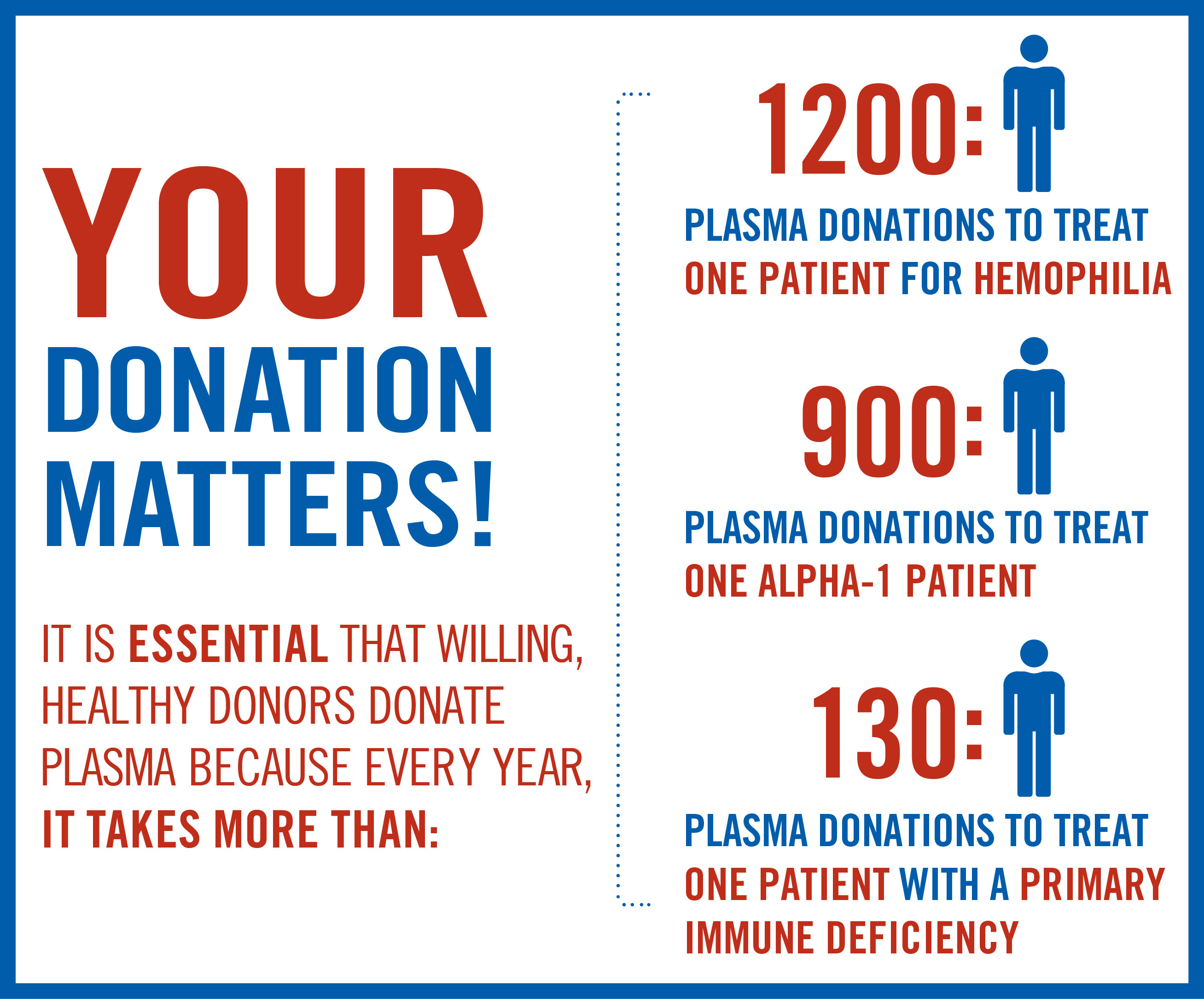What is Plasma Donation and How Does it Work?
Plasma donation is a process where individuals donate their plasma, a liquid component of blood, to help create life-saving therapies for patients with rare and serious diseases. Plasma is the clear, straw-colored liquid portion of blood that makes up about 55% of its total content. It is rich in proteins, including antibodies, clotting factors, and albumin, which are essential for various medical treatments.
The plasma donation process typically involves the following steps: registration, medical screening, and donation. During the donation process, the donor’s blood is drawn into a special device that separates the plasma from the other blood components. The plasma is then collected and frozen for later use, while the remaining blood components are returned to the donor’s body.
Plasma is used to create a range of therapies, including clotting factor concentrates for hemophilia patients, immunoglobulin for patients with immune system disorders, and albumin for patients with liver or kidney disease. The demand for plasma is high, and the process of donating plasma is crucial to meeting this demand.
Donating plasma is a safe and relatively painless process. Donors can typically donate twice within a 7-day period, with at least 2 days in between donations. The entire process, from registration to donation, usually takes about 1-2 hours. While donating plasma is a rewarding experience, it’s essential to understand the compensation involved. The amount of money one can make selling their plasma varies depending on the location, donation frequency, and individual characteristics.
On average, plasma donors can earn between $20 to $50 per donation, with some centers offering more for frequent donors or those with specific blood types. While the financial rewards may not be substantial, the sense of fulfillment and contribution to the medical community can be significant. For those interested in donating plasma, it’s essential to research local donation centers, understand the compensation, and weigh the benefits and risks involved.
As the demand for plasma continues to grow, the opportunity to make money selling plasma becomes increasingly attractive. However, it’s crucial to prioritize the medical screening process and ensure that donors are eligible and healthy enough to donate. By understanding the plasma donation process and the compensation involved, individuals can make informed decisions about their participation in this life-saving endeavor.
The Financial Rewards of Selling Your Plasma
One of the primary motivations for individuals to sell their plasma is the financial reward. The amount of money one can make selling their plasma varies depending on several factors, including the location, donation frequency, and individual characteristics. On average, plasma donors can earn between $20 to $50 per donation, with some centers offering more for frequent donors or those with specific blood types.
The frequency of donations allowed also plays a significant role in determining the total potential earnings. In the United States, for example, the FDA allows individuals to donate plasma twice within a 7-day period, with at least 2 days in between donations. This means that donors can potentially earn up to $100 per week, or $400 per month, by donating plasma regularly.
However, it’s essential to note that the financial rewards of selling plasma can vary significantly depending on the donation center and location. Some centers may offer higher payment rates or more frequent donation opportunities, while others may have stricter eligibility criteria or lower payment rates. To maximize earnings, it’s crucial to research local donation centers and understand their payment structures and eligibility criteria.
Additionally, some plasma donation centers offer referral programs or promotions that can increase earnings. For example, some centers may offer a bonus for referring friends or family members to donate plasma. Others may offer loyalty programs or rewards for frequent donors. By taking advantage of these programs, individuals can potentially increase their earnings and make selling plasma a more lucrative opportunity.
When considering the financial rewards of selling plasma, it’s also essential to factor in the time and effort required for each donation. While the actual donation process typically takes about 1-2 hours, the entire process, from registration to donation, can take up to 3-4 hours. This means that donors need to weigh the financial rewards against the time and effort required for each donation.
Overall, selling plasma can be a financially rewarding opportunity for individuals who meet the eligibility criteria and are willing to donate regularly. By understanding the payment structures, donation frequency, and referral programs offered by local donation centers, individuals can maximize their earnings and make the most of this opportunity.
How to Get Started with Plasma Donation
Getting started with plasma donation is a straightforward process that requires some basic steps. To begin, individuals must find a reputable plasma donation center in their area. This can be done by searching online or checking with local hospitals or medical centers. Once a donation center is found, individuals can visit their website or contact them directly to learn more about their eligibility criteria and donation process.
The eligibility criteria for plasma donation typically include being at least 18 years old, weighing at least 110 pounds, and being in good overall health. Donors must also pass a medical screening, which includes a physical examination, blood test, and review of medical history. This screening process is designed to ensure that donors are healthy enough to donate plasma and that their plasma is safe for use in medical treatments.
Once an individual has determined that they are eligible to donate plasma, they can schedule an appointment at the donation center. On the day of the appointment, donors will be required to provide identification and proof of residency, as well as undergo a brief medical screening. This screening will include a review of their medical history, a physical examination, and a blood test to ensure that their plasma is safe for use in medical treatments.
After the screening process is complete, donors will be escorted to a comfortable donation area where they will be seated in a reclining chair. A trained medical professional will then insert a sterile needle into a vein in the donor’s arm, and the plasma will be collected using a specialized device. The entire donation process typically takes about 1-2 hours, and donors will be monitored throughout the process to ensure their safety and comfort.
After the donation is complete, donors will be given a payment for their plasma, which can range from $20 to $50 per donation, depending on the donation center and the donor’s eligibility. Donors will also be provided with a snack and a drink to help them recover from the donation process.
Overall, getting started with plasma donation is a simple and straightforward process that requires some basic steps. By finding a reputable donation center, meeting the eligibility criteria, and undergoing a medical screening, individuals can begin donating plasma and earning money for their efforts.
Maximizing Your Earnings: Tips and Strategies
To maximize earnings from selling plasma, it’s essential to understand the various strategies that can increase payment rates and donation frequency. One of the most effective ways to boost earnings is to donate frequently. Most plasma donation centers allow donors to donate twice within a 7-day period, with at least 2 days in between donations. By donating regularly, individuals can increase their overall earnings and make the most of their time.
Another strategy to increase earnings is to refer friends and family members to donate plasma. Many donation centers offer referral programs that reward donors for bringing in new donors. These programs can provide an additional source of income and help donors earn more money for their plasma.
Taking advantage of promotions and special offers is also an excellent way to maximize earnings. Some donation centers offer bonus payments for donating during peak hours or for referring multiple donors. By staying informed about these promotions, individuals can increase their earnings and make the most of their plasma donations.
Additionally, choosing the right donation center can also impact earnings. Some centers offer higher payment rates or more frequent donation opportunities than others. By researching and comparing different donation centers, individuals can find the best option for their needs and maximize their earnings.
It’s also essential to understand the payment structures and eligibility criteria for each donation center. Some centers may offer more money for donors with specific blood types or for those who donate more frequently. By understanding these criteria, individuals can optimize their donation schedule and maximize their earnings.
Finally, maintaining good health and hygiene practices is crucial to maximizing earnings. Donors who are in good health and have a clean medical history are more likely to be eligible to donate and can donate more frequently. By taking care of their health and following proper hygiene practices, individuals can increase their earnings and make the most of their plasma donations.
By following these tips and strategies, individuals can maximize their earnings from selling plasma and make the most of this lucrative opportunity. Whether you’re looking to supplement your income or simply want to make some extra money, selling plasma can be a rewarding and profitable experience.
Understanding the Risks and Side Effects
While selling plasma can be a lucrative opportunity, it’s essential to understand the potential risks and side effects associated with the process. As with any medical procedure, plasma donation carries some risks, and it’s crucial to be aware of these before making a decision.
One of the most common side effects of plasma donation is fatigue. This is usually mild and temporary, but in some cases, it can be more severe. Donors may also experience dizziness or lightheadedness after donating, which can be caused by a temporary drop in blood pressure.
Citrate reaction is another potential side effect of plasma donation. This occurs when the citrate anticoagulant used in the donation process reacts with the donor’s blood, causing symptoms such as numbness, tingling, or muscle weakness. In rare cases, citrate reaction can be more severe and require medical attention.
In addition to these side effects, plasma donation can also cause some long-term risks. For example, frequent donors may be at risk of developing anemia or other blood disorders. There is also a small risk of infection or allergic reaction to the donation process.
It’s essential to note that these risks and side effects are relatively rare and that most donors experience no adverse effects from selling plasma. However, it’s crucial to be aware of these potential risks and to take steps to minimize them. This includes following proper donation procedures, staying hydrated, and reporting any side effects or concerns to medical staff.
Donation centers also take steps to minimize the risks associated with plasma donation. This includes screening donors for eligibility, monitoring their health during the donation process, and providing medical attention if needed. By understanding the potential risks and side effects of plasma donation, donors can make informed decisions and take steps to ensure their safety and well-being.
Overall, while selling plasma carries some risks and side effects, these can be minimized by following proper procedures and taking steps to ensure donor safety. By understanding the potential risks and benefits, donors can make informed decisions and take advantage of this lucrative opportunity.
Comparing Plasma Donation Centers: What to Look For
When considering plasma donation, it’s essential to compare different donation centers to find the best one for your needs. With various centers offering different payment rates, donation frequencies, and overall experiences, it’s crucial to do your research and choose a center that aligns with your goals and preferences.
One of the primary factors to consider when comparing plasma donation centers is the payment rate. Different centers offer varying payment rates, ranging from $20 to $50 per donation, depending on the location, donation frequency, and individual characteristics. Some centers may also offer bonus payments for referring friends or donating during peak hours.
Donation frequency is another critical factor to consider. Some centers may allow donors to donate more frequently than others, which can impact overall earnings. It’s essential to understand the donation schedule and frequency of each center to determine which one best suits your needs.
The overall experience of the donation center is also an important consideration. This includes the cleanliness and comfort of the facility, the friendliness and professionalism of the staff, and the efficiency of the donation process. A positive experience can make a significant difference in your decision to return to the center and recommend it to others.
Additionally, some plasma donation centers may offer additional benefits, such as free medical screenings, loyalty programs, or rewards for frequent donors. These benefits can enhance the overall experience and provide additional value to donors.
When comparing plasma donation centers, it’s also essential to consider the eligibility criteria and screening process. Some centers may have stricter eligibility criteria or more comprehensive screening processes, which can impact your ability to donate. Understanding these criteria and processes can help you determine which center is the best fit for you.
By considering these factors and comparing different plasma donation centers, you can make an informed decision and choose a center that meets your needs and provides the best overall experience. Whether you’re looking to maximize your earnings or simply want to donate plasma for the first time, researching and comparing donation centers can help you achieve your goals.
Real-Life Examples: Success Stories from Plasma Donors
Many individuals have successfully sold their plasma and earned a significant income from it. Here are a few real-life examples of plasma donors who have shared their experiences and tips for success.
One plasma donor, who wishes to remain anonymous, has been donating plasma for over a year and has earned over $10,000. This individual donates plasma twice a week and has developed a routine that allows them to maximize their earnings. They recommend donating during peak hours, referring friends, and taking advantage of promotions to increase earnings.
Another plasma donor, Sarah, has been donating plasma for six months and has earned over $5,000. Sarah donates plasma once a week and has found that it helps her pay for her living expenses while she is in college. She recommends finding a donation center that is convenient and has a friendly staff, as it makes the donation process much easier.
John, a plasma donor from California, has been donating plasma for over two years and has earned over $20,000. John donates plasma twice a week and has developed a strategy that allows him to maximize his earnings. He recommends donating during peak hours, referring friends, and taking advantage of promotions to increase earnings.
These real-life examples demonstrate that selling plasma can be a lucrative opportunity for individuals who are willing to put in the time and effort. By following the tips and strategies outlined in this article, individuals can maximize their earnings and make the most of their plasma donations.
It’s worth noting that these success stories are not unique, and many individuals have reported earning significant income from selling their plasma. However, it’s essential to remember that plasma donation is a medical process, and individuals should prioritize their health and safety above all else.
By sharing these real-life examples, we hope to inspire and motivate readers to consider selling their plasma as a viable opportunity. Whether you’re looking to earn some extra money or simply want to help others, plasma donation can be a rewarding and lucrative experience.
Conclusion: Is Selling Your Plasma Worth It?
In conclusion, selling plasma can be a worthwhile opportunity for individuals who are willing to put in the time and effort. With the potential to earn up to $50 per donation and donate twice a week, plasma donation can be a lucrative way to supplement your income. However, it’s essential to consider the potential risks and side effects, such as fatigue, dizziness, and citrate reaction, and to prioritize your health and safety above all else.
By understanding the plasma donation process, the financial rewards, and the potential risks and side effects, individuals can make an informed decision about whether selling plasma is right for them. Additionally, by following the tips and strategies outlined in this article, individuals can maximize their earnings and make the most of their plasma donations.
Ultimately, whether or not selling plasma is worth it depends on individual circumstances and priorities. However, for those who are willing to put in the time and effort, plasma donation can be a rewarding and lucrative experience. By providing a comprehensive overview of the plasma donation process and the potential benefits and drawbacks, this article aims to empower readers to make informed decisions about their health and financial well-being.
In summary, selling plasma can be a worthwhile opportunity for individuals who are willing to put in the time and effort. By understanding the plasma donation process, the financial rewards, and the potential risks and side effects, individuals can make an informed decision about whether selling plasma is right for them. With the potential to earn up to $50 per donation and donate twice a week, plasma donation can be a lucrative way to supplement your income.






